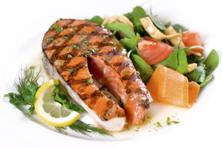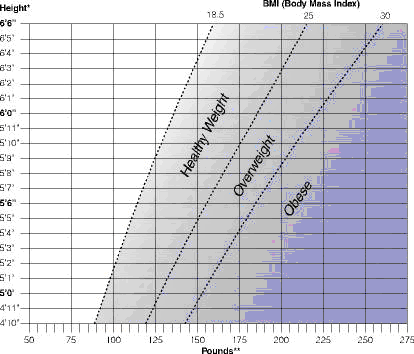Fall 2009: To Your Health
In this Issue:
- Reap the Many Benefits of Yoga
- Can Omega 3 Fatty Acids Protect Against Advanced Prostate Cancer?
- How Does Nutrition Affect Dental Hygiene?
- Weight Control in Young Adulthood May Reduce Risk for Pancreatic Cancer
- Practice Safe Food Handling to Ensure a Happy Thanksgiving
- Feature Food of the Month: Pumpkin
- Healthy Recipe of the Month: Pumpkin Pasta Bake
Reap the Many Benefits of Yoga
September is National Yoga Month!
Yoga is a system of physical and mental exercise that dates back more than 5,000 years. The word yoga is defined as “to join or yoke together” and it is designed to do just that- to bring the mind and body together in harmony. Yoga is based on three main structures: exercise, breathing and meditation. The body is highly respected in yoga practice and the exercises are designed to pressure the body and make it work as efficiently as possible. The concept of breath as the source of life is especially important to yoga. It is believed that increased breath control can improve the health and function of the body and mind. When the principles of exercise and breathing work together, the body is then prepared for meditation.
Today, approximately 11 million Americans are enjoying the practice of yoga. What many may not know is that its benefits reach beyond simply improving strength, flexibility and balance.
Stress: Yoga is a powerful tool to use in stress relief. Many people turn to meditation as a way to quiet the mind and combat stress, but stress doesn’t only affect the mind. It also causes physical responses such as muscle tension, increased heart rate, and changes in breathing patterns. Stress can also cause the body to secrete more hormones that increase blood glucose levels and raise blood pressure. Yoga works in a positive way on all of the body systems to relieve both the physical and mental affects of stress.
Depression: Commonly, low levels of the neurotransmitter GABA are found in people with depression. Research from the Boston University School of Medicine and Harvard’s McLean Hospital discovered that healthy individuals who practiced yoga for an hour had a 27 % increase in levels of GABA compared with control individuals who sat and read for an hour.
Heart Disease: It is well known that any physical activity is beneficial for heart health, but the relaxation and meditative component of yoga may enhance its effect. Researchers speculate that meditation can stabilize the lining of the blood vessels that contribute to cardiovascular disease when irritated.
Breast Cancer: While it may not necessarily prevent the development of breast cancer, research is supporting the theory that patients who do yoga during and after cancer treatment experience less physical pain and stress. In a preliminary study from Duke University, women with metastatic breast cancer took part in 8 weekly yoga sessions. The subjects reported feeling less discomfort, more energy, and more relaxed.
Menopause: A study out of the University of California, San Francisco, reported a 30% decrease in hot flashes in menopausal women who took weekly restorative yoga classes consistently for two months. Another study performed at the University of Illinois followed women taking a 90 minute yoga class twice a week for four months. Many of the women reported a boost in their energy and mood, as well as reduced stress and anxiety, and a decrease in physical and sexual discomfort.
Chronic Back Pain: It is important to note that certain yoga poses and extreme movement in a certain direction can make back pain worse, so always consult a physician before beginning any fitness regimen. However, the HMO Group Health Cooperative in Seattle found that patients who engaged in 12 weekly sessions of yoga showed greater improvement and longer lasting benefits than patients who practiced therapeutic exercises and were given a handbook on self-care.
The American College of Sports Medicine and the American Heart Association together recommend at least 30 minutes of moderate exercise five times a week to maintain health, so whether you’re looking to soothe the symptoms of a medical condition, relax your mind, or just get in shape, yoga is a great form of exercise to incorporate into your healthy lifestyle. The only way to reap the rewards yoga has to offer is to try it out for yourself! Consider adding it to your workout 2 or 3 times a week. Classes are widely available at local gyms and fitness centers, spas, recreation centers, and private yoga studios.
Click here for easy tips to help you add more exercise in your life, and maybe even squeeze in a yoga session!
Can Omega 3 Fatty Acids Protect Against Advanced Prostate Cancer?

The prostate is a gland in the male reproductive system that sits below the urinary bladder and in front of the rectum. It is an important component of male sexual function and plays a role in controlling the flow of urine. Cancer of the prostate is the most common non-skin cancer in America, affecting 1 in 6 men. The National Cancer Institute estimates that in 2009 more than 192,000 new cases of prostate cancer will be diagnosed, and more than 27,000 men will subsequently die from the disease. In a recent study performed at the Institute for Human Genetics, Epidemiology & Biostatistics at the University of California, San Francisco, researchers reported that eating a healthy diet rich in dark fish and other sources of omega-3 fatty acids may decrease the risk of advanced prostate cancer, even in men with a genetic predisposition to the disease.
This clinical trial studied 466 men with advanced prostate cancer and 478 healthy men. They found that increased consumption of omega-3 polyunsaturated fatty acids, from dark fish such as salmon, had protective properties against prostate cancer. The link remained even in men with a known high-risk genetic predisposition to the disease. On the other hand, the risk of being diagnosed with prostate cancer in men with a low intake of omega-3’s and the genetic predisposition increased by 5 times. Researchers discovered that those with the highest intake of omega-3 fatty acids had a 63% lower risk of developing aggressive prostate cancer compared to the men with the lowest omega-3 intake.
Although the results of this study sound promising, more research is needed to confirm the role of omega 3’s in prostate cancer prevention. To reduce your risk of this disease and many others, eat a well balanced diet and maintain a healthy body weight, as several studies have found obesity to be a preventable risk factor for developing prostate cancer.
References: 1. National Cancer Institute 2. Fradet, Vincent, et al. Dietary Omega-3 Fatty Acids, Cyclooxygenase-2 Genetic Variation, and Aggressive Prostate Cancer Risk. Clin Cancer Res 2009 0: 1078-0432.CCR-08-2503
Click here to learn about nutritious eating while undergoing prostate cancer treatment.
How Does Nutrition Affect Dental Hygiene?
October is National Dental Hygiene Month!
Most people know that eating an excess amount of sugary foods will contribute to the development of dental caries, more commonly known as cavities. What you may not realize is that the foods we eat to build and maintain strong bones and muscles also contribute to strong teeth and healthy gums.
Foods that support dental health:
- Dairy products: Calcium and vitamin D are essential for strengthening teeth.
- Whole grain or enriched breads and cereals: B vitamins promote soft tissue growth and iron promotes healthy blood, which contribute to healthy gum tissue.
- Fruits and vegetables: Vitamin C is a powerful antioxidant that is necessary to maintain healthy gums.
- Lean meat, fish, poultry and beans: Magnesium and zinc promote strong teeth and bones much like calcium, while iron and protein are necessary for overall health.
It is important to also keep in mind the ways your diet and eating habits can negatively affect dental hygiene so you are aware of how to make improvements:
- Acid Erosion: Acid erosion, the dissolving of minerals like calcium and phosphorous from the tooth structure, causes tooth wear. When plaque, a sticky film of bacteria that forms on the surface of the teeth, comes into contact with food, sugars break down into acids, causing the mouth to shift from a neutral environment to an acidic environment. The longer your teeth are exposed to this acidity, the higher the risk of demineralization. Sticky, sugary foods like caramel, jams, gummy candies, and even raisins, dried fruit and honey stick to the teeth for much longer than other foods, providing an optimal environment for bacteria to work. This is why it is so important to brush teeth after meals when possible!
- Meal frequency: How often and for how long the teeth are exposed to an acidic environment after eating is more important than the actual amount of food consumed. When meals are eaten frequently throughout the day, the teeth do not have enough time to remineralize in between.
- Soda: A can of soda contains almost 10 teaspoons of sugar and is very acidic. Both of these factors contribute to tooth wear. Many soda drinkers have the habit of swishing the soda around in the mouth, exposing the surface of the teeth for a longer period of time. Such prolonged exposure to an acidic environment will increase the risk of tooth wear and erosion. To avoid this, it is best to drink quickly rather than taking small sips over a long period of time.
- Dentin Hypersensitivity: Extrinsic factors including acidic foods, carbonated beverages, sports drinks, red and white wines, and citrus fruits can have erosive effects on dentin, the dental tissue found under the tooth enamel. When dentin is eroded one can experience pain triggered by foods and beverages.
Keeping your teeth and gums healthy is an important part of overall health. If your teeth aren’t as strong as possible, eating can be difficult and even painful. By avoiding foods and habits that are detrimental to your teeth and incorporating foods that promote dental health, you’ll be on your way to a sparkling clean and healthy smile.
References: 1. American Dental Hygienists Association 2. The Journal of Professional Excellence: Dimensions of Dental Hygiene
Achieving optimal dental health is possible with some simple lifestyle and diet adjustments. Click here to learn more ways to keep your smile bright and healthy!
Weight Control in Young Adulthood May Reduce Risk for Pancreatic Cancer

November is National Pancreatic Cancer Awareness Month!
The pancreas is an organ located in the abdomen just behind the stomach that has very important functions. The exocrine glands of the pancreas secrete enzymes that are released into the intestines to help digest fat, protein and carbohydrates. The endocrine glands secrete glucagon and insulin, two hormones that help maintain blood glucose levels.
Pancreatic cancer is an aggressive disease. The National Cancer Institute estimates that over 35,000 men and women will die from it in 2009. Because this type of cancer is usually diagnosed in its late stages, the five year survival rate is approximately 5%. Obesity has been consistently associated with increased risk of pancreatic cancer development and a new study found that people who were overweight or obese during young adulthood were at an even greater risk. This study was conducted at the University of Texas Anderson Cancer Center where researchers tested the link between obesity and risk for pancreatic cancer. The results revealed that participants with an increased body mass index (BMI) of 25-30 or greater had an increased risk of developing pancreatic cancer. Participants who were overweight or obese between the ages of 20 and 49 had an onset of pancreatic cancer 2 to 6 years earlier than those with a normal weight. While the results of this research still need further testing and confirmation, it seems that maintaining a healthy body weight will reduce the risk of developing pancreatic cancer.
Maintaining a healthy body weight is necessary not only to reduce cancer risk, but to decrease the likelihood for other diseases and conditions as well. Body mass index, or BMI, is a common indicator of body fatness that is calculated based on height and weight. The Center for Disease Control reports that those who fall into the “overweight” or “obese” BMI ranges consistently have a greater risk of coronary heart disease, stroke, type 2 diabetes, many types of cancer, hypertension, dyslipidemia, sleep apnea and respiratory problems, gynecological problems, and liver and gall bladder disease.
You can calculate your BMI with the following chart to determine what range you’re in:

Although the journey to achieving an appropriate body weight may not be easy, the benefits are undoubtedly worth the effort. Keep in mind that losing or maintaining weight successfully depends on lifestyle changes, not quick fixes or fad diets. As simple as it may seem, your weight ultimately depends on the balancing act between calories in and calories out. By adopting a healthy eating plan and regular exercise regime, you’ll be one step closer to a healthy weight and you’ll slash your risk of many life-threatening conditions.
References: 1. Horner MJ, et al. SEER Cancer Statistics Review, 1975-2006, National Cancer Institute. Bethesda, MD, http://seer.cancer.gov/csr/1975_2006/, based on November 2008 SEER data submission, posted to the SEER web site, 2009. 2. Donghui Li et al. Body Mass Index and Risk, Age of Onset, and Survival in Patients With Pancreatic Cancer. JAMA. 2009;301(24):2553-2562. 3. Center for Disease Control
Click here to learn how medical nutrition therapy can help you or a loved one maintain an appropriate body weight. Contact Bonnie R. Giller, MS, RD, CDN, CDE to get started on your journey to a healthier lifestyle!
Practice Safe Food Handling to Ensure a Happy Thanksgiving
Thanksgiving is a day to enjoy family and friends, to give thanks for all the wonderful things in life, and enjoy a delicious meal. What many may not realize is that bacteria can make its way into your food because of careless mistakes and the many distractions that come along with holiday cooking. Not to worry! There are basic steps you can take to prevent food-borne illness from becoming an additional guest at your Thanksgiving table.
The four key rules to food safety are CLEAN, SEPARATE, COOK and CHILL!
- Wash hands and surfaces often to prevent the spread of bacteria throughout the kitchen.
- Keep raw meat, poultry and fish separate from ready-to-eat foods to prevent the spread of bacteria from one food to another.
- Cook foods to proper temperatures to kill harmful bacteria.
- Refrigerate foods promptly to prevent bacteria from spreading and multiplying.
Turkey Basics
Turkey is the main attraction of most Thanksgiving feasts. If you choose to buy a fresh turkey, do so only 1-2 days prior to cooking. If you choose a frozen turkey, make sure you have enough freezer and refrigerator space for storage and thawing. Because raw poultry often harbors salmonella organisms, it is essential to thaw and cook the turkey properly.
Thawing
The safest way to thaw a turkey is in the refrigerator (40 degrees F) in its original wrapping and on a pan to prevent juices from coming in contact with other foods. Be sure to allow 24 hours of thaw time per 5 pounds of turkey. Once it is thawed, keep refrigerated no more than 2 days before cooking.
Cooking
If you plan to stuff the turkey, stuff loosely. Be sure that the stuffing is moist and not dry. This is important because bacteria are destroyed faster in a moist environment. Immediately place the stuffed turkey in a preheated 325°F oven. Keep in mind that a stuffed turkey will take longer to cook than an unstuffed turkey, about 20-25 minutes per pound. Use a meat thermometer to check the temperature of your cooked turkey. A thoroughly cooked bird will have an internal temperature of 180 degrees when a thermometer is inserted into the thigh meat.
Storing
Store leftovers within 2 hours of serving. Cut the meat into small pieces and store separately from stuffing in shallow containers. Eat refrigerated leftover turkey and stuffing within 3-4 days and leftover gravy within 1-2 days. These foods may be frozen for later use.
Reference: Wisconsin Department of Health Services
Cooking meat to the proper temperature is important all year long, not just at the holidays! Click here to learn the temperatures at which different meats are safe to eat.
Feature Food of the Month: Pumpkin

Pumpkins originated in Central America and date back to the 16th century. It was a staple in the Native American culture, as they used it to make items for trading as well as for food. The Indians would pound the pumpkin into flat strips, dry them, and then weave the strips into mats or baskets. Pumpkin pie originated when colonists in the new world cut off the top of the pumpkin and removed the seeds, filled it with milk, honey and spices, and baked it in hot ashes.
Pumpkin Nutrition
Pumpkins are fun and festive at Halloween, but besides pumpkin pie, have you ever considered adding it into your meals? Pumpkins, like most autumn and winter squash, are packed with nutrients that are great for your health. The rich orange color of pumpkin reveals that the squash is rich in beta-carotene, an antioxidant and precursor to vitamin A that will prevent harmful, cancer-causing agents from damaging the body’s cells. Beta-carotene and other antioxidants found in pumpkin are great for protecting the eyes from developing cataracts by targeting free radicals that damage the lens of the eye. These antioxidants may also reduce the risk of macular degeneration, a medical condition that often results in blindness. Pumpkin is also rich in potassium, a nutrient necessary for fluid balance, and iron, which helps the red blood cells carry oxygen to the rest of the body. It is low in calories, and high in fiber. Just one cup of pumpkin provides approximately 50 calories and 3 grams of fiber. Incorporating plenty of fiber into your diet is important for proper bowel health.
Selection
Pumpkins used in cooking are slightly different than a pumpkin you’d pick for carving. Small “sugar” or “pie” pumpkins are the best choice for cooking. They are smaller, sweeter, and not as watery as a traditional pumpkin. Pick one with a stem of one to two inches. If the stem is cut too low, the pumpkin is likely to decay very quickly. Avoid a pumpkin with blemishes and soft spots. They have a very high water content and should therefore feel heavy.
Cooking
To steam: Cut pumpkin in half and remove seeds and fibers. Place cut-side down in a steamer basket, cover and cook over boiling water, about 15 to 20 minutes or until a knife easily cuts the flesh. The skin will not soften during cooking so be sure to test for doneness on the underside. When the pumpkin has cooled, the skin will harden and separate from the flesh, making it easy to remove by hand. Transfer the flesh to a food processor and puree until smooth.
To microwave: Cut 1 to 3 pounds peeled pumpkin into 1-inch chunks. Arrange in a single layer in a microwave-safe dish large enough to hold them. Cover tightly and cook until tender, stirring halfway through cooking, about 6 minutes. Transfer to a food processor and puree until smooth.
Healthy Recipe: Pumpkin Pasta Bake
Ingredients:
12 ounces uncooked whole wheat penne pasta
1 tsp. olive oil
1 medium onion, finely chopped
2 cloves garlic, finely chopped
2 small zucchini, halved lengthwise, then sliced
½ tsp. dried thyme
1 tsp. dried sage
1 15 ounce can pure pumpkin
1 cup nonfat ricotta cheese
¼ cup shredded parmesan cheese
Directions:
1. Preheat oven to 400 degrees.
2. Cook pasta; reserve ½ cup of cooking water when finished.
3. Sauté onions and garlic in a large skillet for 5-6 minutes, until softened. Stir in zucchini and herbs and sauté for 3-4 minutes.
4. Stir in canned pumpkin and ricotta cheese.
5. Add drained pasta and ½ cup reserved liquid into skillet and mix well.
6. Spray an 11×7 baking dish with nonstick cooking spray. Add pasta mixture to baking dish.
7. Sprinkle with parmesan cheese. Bake for 10-15 minutes.
Yield: 10 servings
Serving Size: 1 piece
Exchanges: 2 starch, ½ meat, ½ vegetable
Nutrition Information:
Calories: 168
Total Fat: 2 grams
Monounsaturated fat: 1 gram
Polyunsaturated fat: 0 grams
Saturated Fat: 0.5 gram
Cholesterol: 7 milligrams
Protein: 10 grams
Carbohydrate: 31 gram
Sodium: 107 milligrams
Dietary Fiber: 6 grams
For more healthy recipes, click here.

Leave a Reply
Want to join the discussion?Feel free to contribute!